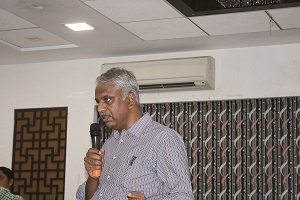Corrugated boxes are the single most preferred medium for tertiary packaging in India as well as globally. Stakeholders such as brand owners, hot melt suppliers, glue applicators, corrugated board manufacturers, converters and machine manufacturers have now begun to agree that end of the line packaging does not end with cost of shipper cartons. Some of the prominent names from the industry gathered at Chembur Gymkhana in Mumbai on 3 May 2016 to discuss future trends in end of the line packaging. The Institute of Packaging Machinery Manufacturers of India (IPMMI), Indian Flexible Packaging and Folding Carton Manufacturers Association (IFCA) and Welbound organized a seminar titled ‘Look Beyond the Box’ where various aspects of the industry were deliberated upon.
Suprotik Das, managing director, Nordson India was the first to make a presentation and talked about the need for the corrugated industry to focus on differentiation and innovation and not rely on copying others and competing on price. He gave the example of German small and medium enterprises and argued that these companies work to secure a long-term relationship with customers and suppliers and work on creating value. “When you copy others you reduce differentiation. This is not the way to do business as it leads to price competition. The right way to do business is to minimize dependence on price as a competitive tool,” he stated.
Kin Tegesen, packaging head – India, Middle East & Africa, Henkel talked about various hot melt solutions in corrugation packaging. Currently the corrugated box industry converts about 4.8 million tonnes of paper into 7 to 7.5 billion square metres of corrugated boxes every year. Till 2007 the industry was regulated with a maximum cap of investment and was dominated by semi-automatic board making facilities. After the cap was lifted there has been rapid growth in the number of automatic facilities. However, semi-automatic facilities still continue to constitute a large part of the industry. The biggest consumer of corrugated boxes in India is the FMCG industry. Other major users are consumer durables, garments, fruits and vegetables and other products.
All these statistics was provided by Manish Patel, managing director of the South India Paper Mills, who talked about the corrugated box manufacturing industry, the challenges it faces and major trends.
Patel pointed out that there has been an increase in automation and productivity in recent years. Moreover, plants are being set up keeping in mind taxation polices and logistical advantage. He informed the audience that most FMCG consumers are now asking for single wall (3-ply) board rather than double wall (5-ply) boards. This is happening because 3-ply is cost-effective and is adequate for FMCG players. Case sealing using hot melt gluing systems tends to increase the overall rigidity of 3-ply boxes and contributes to better in transit performance, Patel said.

Given these emerging requirements, Patel said, corrugated box vendors will need to upgrade box making capabilities while packaging line machinery manufacturers will need to design machines that are cost-effective and reliable. The seminar was concluded with the presentation by P Sajith, director, Welbound, who talked about advantages of hot glue sealing over tapes. He said hot glue sealing improves overall packaging, boosts load bearing capacity of cartons, reduces corrugates, enhances packaging aesthetics, eliminates issues related to taping, enhances recyclability and increases productivity.
Last year Welbound entered into the packaging segment by launching HotCase 500, a top and bottom case sealer for end of the line packaging. The idea behind launching the machine was to create awareness about the advantages that hotmelt adhesive has over tapes when it comes to packing transport cartons. HotCase 500 is being manufactured in collaboration with Nordson and Henkel at Welbound’s Bengaluru plant.











